Road Safety On A Quingo
How To Be Safe Using The Road and Pavements On a Quingo Scooter
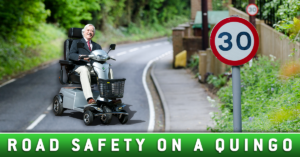
It is of utmost importance to be safe when using a mobility scooter to ensure the rider and scooter are kept unharmed. Poor road safety or recklessness could cause considerable damage to the user as well as other people if they were to collide with something or someone. Here we have put together some road safety guidelines to bear in mind when using an electric mobility scooter since you are responsible for both your own and other people’s safety.
What Class Is My Scooter?
First of all, you should know which class your scooter fits into.
A class 2 scooter has a maximum speed of 4mph and is only suitable for pavements and footpaths. At Quingo these scooters include: Ultra, Flyte and the Classic.
A class 3 scooter has a maximum speed of 8mph and is suitable to be used on roads at this speed. At Quingo these scooters are: Plus, Toura2 and Vitess2.
It is important to note that a Class 3 vehicle is not legally defined as a motor vehicle and the user does not need a driving license or to take a test. However, a Class 3 vehicle can only be used by a disabled person aged 14 or over and you must register a Class 3 vehicle with the DVLA. It must be licensed in the disabled taxation class and display a free disabled tax disc. There is no fee to pay and the vehicle does not need registration plates. However, you must renew your tax disc each year.
Some Quick Tips!
Here are some quick tips that you may not have known about using a mobility scooter…
- Get professional advice before buying a mobility scooter. Ask for a test drive! So that you know exactly what you are spending your money on.
- Remember that the distance you can travel will depend on the condition of the battery, the weight you have on the scooter and the route terrain.
- Cold weather, travelling on rough surfaces and travelling up hills will use more power and reduce the distance you can travel.
- Scooters should be maintained and serviced annually. For more information on servicing you can take a look at our blog on aftercare and servicing on the Quingo website.
- Make sure that you are familiar with all the controls on your scooter before you go out. Quingo carries out a ‘blue diamond’ driver check to ensure you know how to use all features of your new scooter.
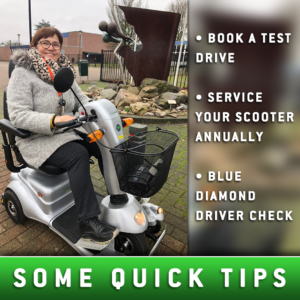
Insurance
Scooter Insurance offers you the peace of mind to do just that every time you go out. Whilst the law states that you are not obliged to have insurance, it is strongly recommended – both by the Quingo team and the Department for Transport that you do.
It’s all too easy to put off getting insurance and many people do but we strongly advise that you don’t. It is far better to protect both your investment and yourself and get covered right away. The process is very straightforward and our friends at First Senior Insurance will happily take you through the application process.
You should also consider Roadside Recovery if you wish to avoid unnecessary worry. Punctures or mechanical problems for example are rare but should you ever find yourself needing help recovering your scooter and getting it and yourself home, it is well worth considering. First Senior Insurance offers such a service which provides a reliable recovery service 24 hours a day and 7 days a week.
Going Out And About
- See and be seen! If you are using anything to protect you from the weather, make sure that it does not restrict your vision. Wear fluorescent and reflective materials and have fluorescent and reflective markings on your scooter, and put on your lights to help other road users see you.
- Mobility scooters are constructed and designed for the driver only. Think! Don’t put yourself in any danger by carrying passengers.
- Overloading your scooter with shopping or other goods can also make the vehicle unstable, so make sure you don’t overload the carrying capacity of your scooter which can be found in the users’ handbook.
- Bags hanging from the handlebars will also make the scooter more difficult to control.
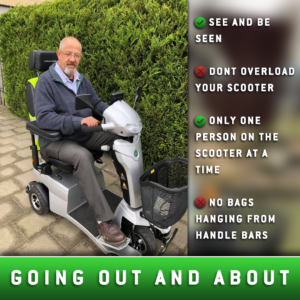
Using Scooters On The Pavement
Some scooters are designed only to be driven safely on pavement or footpaths, except when you are crossing roads. If you are riding a Class 3 vehicle, you must switch over to the 4 miles an hour setting when you are using it on a pavement or footpath. If you are in a crowded area or in a shop it is safer to go slower than 4mph as you must not run into anyone or cause any damage.
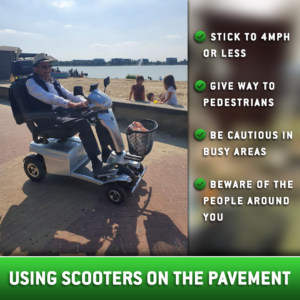
Using Scooters On The Road Safely
To drive on the road you need a vehicle that can travel at up to 8 miles an hour. It must also have headlights, rear lights, flashing indicators, a wing mirror and a horn. Here are some other things to bear in mind…
- You must follow the Highway Code and drive on the left-hand side.
- Please be aware that currently you are not allowed to use bus lanes or cycle tracks. A read-through of the Highway Code will help in your understanding of signs and road markings.
- You must obey traffic lights and all other road signals and instructions, including stop signs, give-way signs and signs for one-way streets.
- Always give way to pedestrians.
- At night, you must have your headlights and rear lights on.
- Remember that other vehicles are driving faster than you. Be sure that you have plenty of time to carry out your actions.
- Don’t rely on your mirror. It may give a false impression of distance.
- Also, look behind when turning right. It may be safer to turn on to the pavement and use a pedestrian crossing to cross the road. If there is no pavement, it may be safer to stop on the left and wait for a gap in the traffic.
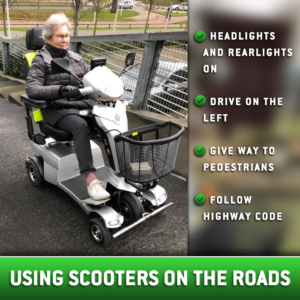
So when you next use your mobility scooter, or you are thinking of purchasing one soon it is important to be safe and know the rules of the road or the pavement depending on what scooter you own. Keep yourself and others safe by using the Quingo safety guide!
